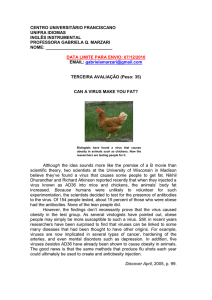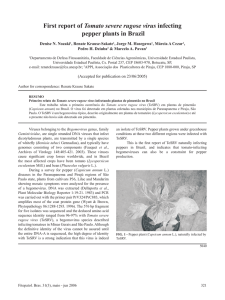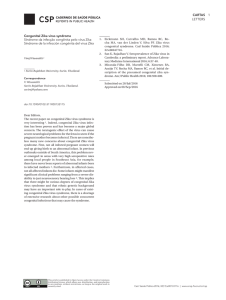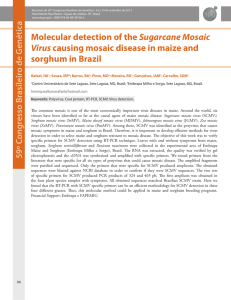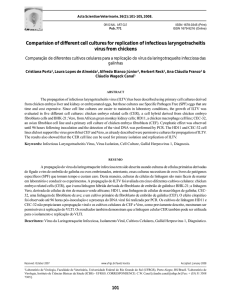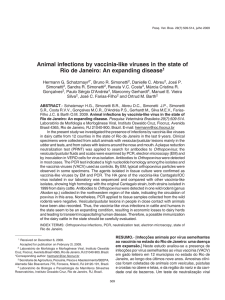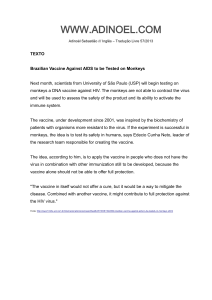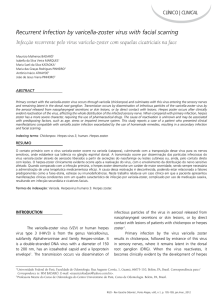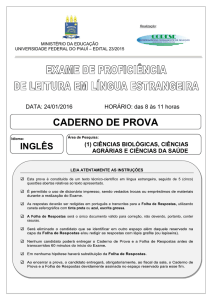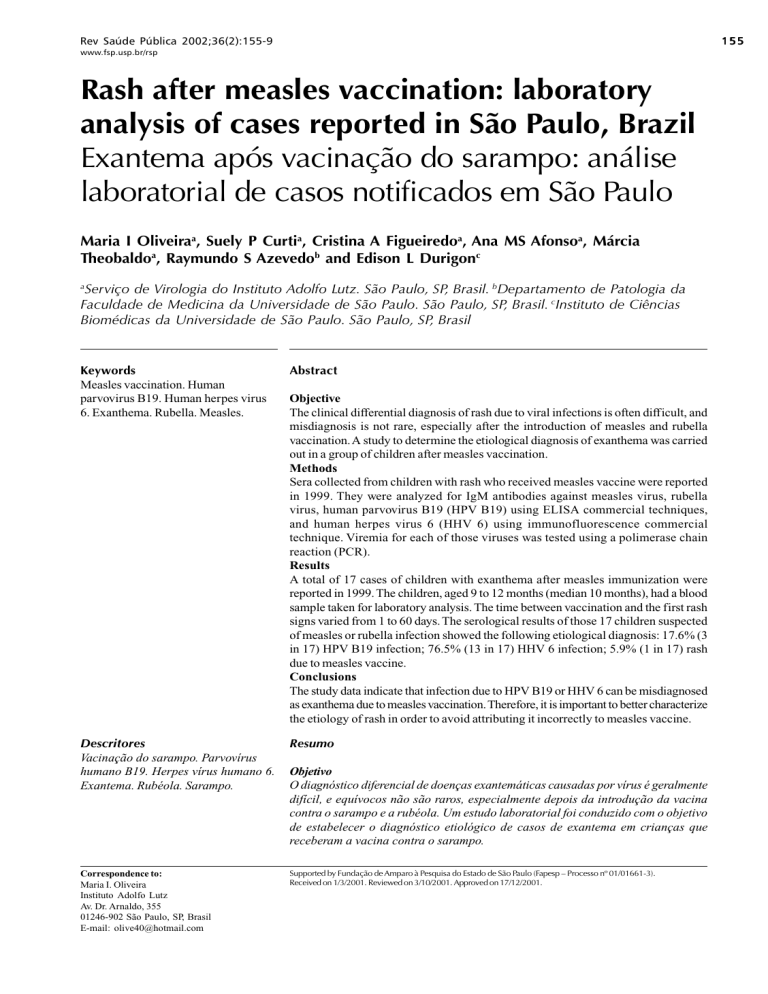
155
Rev Saúde Pública 2002;36(2):155-9
www.fsp.usp.br/rsp
Rash after measles vaccination: laboratory
analysis of cases reported in São Paulo, Brazil
Exantema após vacinação do sarampo: análise
laboratorial de casos notificados em São Paulo
Maria I Oliveiraa, Suely P Curtia, Cristina A Figueiredoa, Ana MS Afonsoa, Márcia
Theobaldoa, Raymundo S Azevedob and Edison L Durigonc
a
Serviço de Virologia do Instituto Adolfo Lutz. São Paulo, SP, Brasil. bDepartamento de Patologia da
Faculdade de Medicina da Universidade de São Paulo. São Paulo, SP, Brasil. cInstituto de Ciências
Biomédicas da Universidade de São Paulo. São Paulo, SP, Brasil
Keywords
Measles vaccination. Human
parvovirus B19. Human herpes virus
6. Exanthema. Rubella. Measles.
Abstract
Descritores
Vacinação do sarampo. Parvovírus
humano B19. Herpes vírus humano 6.
Exantema. Rubéola. Sarampo.
Resumo
Correspondence to:
Maria I. Oliveira
Instituto Adolfo Lutz
Av. Dr. Arnaldo, 355
01246-902 São Paulo, SP, Brasil
E-mail: [email protected]
Supported by Fundação de Amparo à Pesquisa do Estado de São Paulo (Fapesp – Processo nº 01/01661-3).
Received on 1/3/2001. Reviewed on 3/10/2001. Approved on 17/12/2001.
Objective
The clinical differential diagnosis of rash due to viral infections is often difficult, and
misdiagnosis is not rare, especially after the introduction of measles and rubella
vaccination. A study to determine the etiological diagnosis of exanthema was carried
out in a group of children after measles vaccination.
Methods
Sera collected from children with rash who received measles vaccine were reported
in 1999. They were analyzed for IgM antibodies against measles virus, rubella
virus, human parvovirus B19 (HPV B19) using ELISA commercial techniques,
and human herpes virus 6 (HHV 6) using immunofluorescence commercial
technique. Viremia for each of those viruses was tested using a polimerase chain
reaction (PCR).
Results
A total of 17 cases of children with exanthema after measles immunization were
reported in 1999. The children, aged 9 to 12 months (median 10 months), had a blood
sample taken for laboratory analysis. The time between vaccination and the first rash
signs varied from 1 to 60 days. The serological results of those 17 children suspected
of measles or rubella infection showed the following etiological diagnosis: 17.6% (3
in 17) HPV B19 infection; 76.5% (13 in 17) HHV 6 infection; 5.9% (1 in 17) rash
due to measles vaccine.
Conclusions
The study data indicate that infection due to HPV B19 or HHV 6 can be misdiagnosed
as exanthema due to measles vaccination. Therefore, it is important to better characterize
the etiology of rash in order to avoid attributing it incorrectly to measles vaccine.
Objetivo
O diagnóstico diferencial de doenças exantemáticas causadas por vírus é geralmente
difícil, e equívocos não são raros, especialmente depois da introdução da vacina
contra o sarampo e a rubéola. Um estudo laboratorial foi conduzido com o objetivo
de estabelecer o diagnóstico etiológico de casos de exantema em crianças que
receberam a vacina contra o sarampo.
156
Rash after measles vaccination
Oliveira MI et al.
Rev Saúde Pública 2002;36(2):155-9
www.fsp.usp.br/rsp
Métodos
Soros de casos de exantema em crianças que receberam vacina contra o sarampo, em
1999, foram analisados para anticorpos IgM contra os vírus do sarampo, da rubéola
e do parvovírus humano B19 (HPV B19), por técnicas comerciais de Elisa, e o herpes
vírus humano tipo 6 (HHV 6), por técnica comercial de imunofluorecência. A viremia
para cada um desses vírus foi testada pela reação em cadeia da polimerase (PCR).
Resultados
Foram notificados, em 1999, 17 casos de crianças com exantema pós-vacinal. A
idade das crianças era de nove a 12 meses (mediana, dez meses). Uma amostra de
sangue colhida para investigação laboratorial foi obtida para cada criança. O
tempo decorrido entre a aplicação da vacina e o aparecimento do exantema variou
de um a 60 dias. Os resultados da sorologia das 17 crianças sugeriram o seguinte
diagnóstico etiológico para o exantema: 17,6% (três em 17) infecção pelo HPV
B19; 76,5% (13 em 17) infecção pelo HHV 6; 5,9% (um em 17) exantema originado
pela vacina do sarampo.
Conclusão
Os resultados indicaram que a infecção pelo HPV B19 ou pelo HHV 6 pode ser
diagnosticada como sarampo de origem vacinal. Portanto, é fundamental incluir
esses vírus no diagnóstico laboratorial para corretamente apontar a etiologia das
doenças exantemáticas, evitando, assim, atribuir à vacina do sarampo efeito colateral.
INTRODUCTION
The scarcity of clinical disease, as an expected outcome of an effective measles vaccination program,
makes it more difficult for clinicians to diagnose correctly the etiology of exanthematic diseases. Also,
atypical cases may occur due to other viruses and be
mistaken as measles. Studies on immune responses
after measles vaccination showed clinical reactions,
such as fever and rash, observed 10 days after immunization. This has led to the hypothesis that an abnormally intense cellular immune response may account for vaccine-induced measles infection.13 The
classic measles is typically a childhood infection with
high fever for 2 to 3 days, and a rash that coincides
with the appearance of the immune response.6,7 But
many childhood viral diseases may present rash and
fever, namely: rubella, human herpes 6 (HHV 6) and
human parvovirus B19 (HPV B19), among others.
HHV 6 was recognized as the agent responsible for
exanthema subitum/roseola, which occurs at an early
age, between the ages of 6 and 18 months. It is the
most common infectious exanthema during the first
two years of life; 82% of all cases occur during this
period, and it is characterized by a febrile episode that
lasts 3 to 5 days, skin rashes developing after fever,
and the rashes continuing to affect pigmentation. This
leads to antibody prevalence of up to 80-100% in
adults. Although low prevalence was found in some
areas, further comparisons are necessary to determine
the differences between various racial and ethnic
groups and the geographic distribution of the virus.15
HPVB19 infection can occur in all age groups. The
reported seroprevalence ranges from 15% to 60% in
children aged 5-19 years. The level of transmission
in a community seems to vary from year to year. A
facial rash is characteristic of the illness, but it also
occurs on the torso and extremities. Recurrence of
the rash may take place several weeks following nonspecific stimuli such as change in temperature.2
The disease caused by the rubella virus is more
important when the infection occurs in pregnant
women during the first trimester, causing defects in
organ formation of the fetus. Rubella virus can be
congenitally acquired. It can be recovered from nasopharyngeal secretions of 50-60% infants by the
age of 3 months and from about 10% by the age of
9-12 months.
Typical rubelliform rashes may be a result of enterovirus, HPVB19, and some arboviruses infections,
which may cause both rubelliform rashes and arthralgia. Rubella vaccines are well tolerated, although rash,
lymphadenopathy and arthropathy may occur between 10 days to 4 weeks after vaccination.3
Differential diagnosis among measles virus (MV),
rubella virus (RV), HPV B19 and HHV 6 infections has
been associated with a variety of other exanthemas,
particularly if the patient shows a rash after the classic
prodromic phase, which increases the difficulty of an
accurate diagnosis based on clinical symptoms.7
The present study aims to establish the etiology of
rash after measles vaccination by laboratory analysis
of sera taken from cases reported in the state of São
Paulo, Brazil.
Rash after measles vaccination
Oliveira MI et al.
Rev Saúde Pública 2002;36(2):155-9
www.fsp.usp.br/rsp
METHODS
traction and reverse transcriptase (RT-PCR). The methods and primers were described by Rota.11
Patients and samples
Rubella virus (RV)
There were 109 cases of measles confirmed in 1999,
reported to the Health Department of the state of São
Paulo as part of the Measles Surveillance Program.
Seventeen cases of children with manifested symptoms after measles immunization were studied. The
vaccinated children aged 9 to 12 months and presented exanthema 1 to 60 days after measles vaccination with clinical hypotheses of measles or rubella
infection (Table).
ELISA assay
The assay used for the detection of RV antibodies
was the Rubenostika IgM II micro Elisa system.
PCR assay
The detection of RV in sera was done from total
RNA extracted using the guanidinium isothiocyanate
method and reverse transcriptase-PCR (RT-PCR) followed by Nested-PCR. The methods and primers were
described by Jennifer.3
Blood samples were collected and their sera were
tested for IgM specific following the manufacturer
instructions. Polimerase chain reaction (PCR) was
used to detected measles virus (MV), rubella virus
(RV), HHV 6 and HPV B19.
Human herpes virus 6 (HHV 6)
Imunofluorescence assay
Measles virus (MV)
HHV 6 IgM immunofluorescence assay was used.
ELISA assay
Measles virus specific IgM were tested with three
different kits:
1) Measles IgM capture enzyme immunoassay –
CDC, Atlanta, GA;
2) Measles IgM capture enzyme immunoassay;
3) Enzygnost® anti-masern – virus/IgM.
PCR assay
PCR assay
Human parvovirus B19 (HPV B19)
The detection of MV RNA was from serum RNA
isolated using protocols of RNA isolation for acid
guanidinium isothiocyanate-phenol-chloroform ex-
ELISA assay
The detection of HHV 6 in the sera was done using
phenol and chloroform treatment and alcohol precipitation. The Nested-PCR assay with primers and
methods were described by Huang.15
HPV B19 sera samples were tested using ELISA to
Table - Results of IgM serology and PCR for MV, RV, HPV B19 and HHV6, as well as the final diagnosis report.
Patient
N
Gender
Age in
months
1
F
12
2
F
9
3
M
9
4
F
10
5
F
12
6
F
9
7
F
11
8
F
10
9
M
9
10
F
10
11
F
10
12
M
9
13
F
11
14
M
10
15
M
11
16
F
9
17
F
12
PCR – polimerase chain reaction
HHV – human herpes virus
Time between
vaccination
and onset the
rash (days)
Time
Time between
PCR and IgM
between
onset of the
vaccination rash and blood
and blood
collection
collection (days) (days) HPV-B19 HHV6 MV
2
1
14
2
15
4
3
3
5
60
15
24
29
9
21
60
MV – meales virus
7
6
15
15
29
11
60
60
16
9
15
60
26
29
9
24
60
3
5
1
13
4
7
3
2
12
1
0
2
1
0
3
3
RV – rubella virus
+
+
+
-
+
+
+
+
+
+
+
+
+
+
+
+
+
HPV –
Final
diagnosis
RV
+
HHV6
+
HHV6
MV
+
HHV6
+
HHV6
+
HHV6
+
HHV6
+
HHV6
+
HHV6
+
HHV6
+
HHV6
+
HHV6
+
HHV6
HPV-B19
HPV-B19
HPV-B19
+
HHV6
human parvovirus
157
158
Rash after measles vaccination
Oliveira MI et al.
detect IgM antibodies specific to parvovirus B19.
PCR assay
The detection of HPVB19 DNA in sera was done
by using the method of detergent and proteinase K
for DNA extraction. Oligonucleotides for Nested-PCR
assay were described by Durigon.5
RESULTS
The following results were obtained from 17 children aged 9 and 12 months with exanthema after
measles immunization.
In 17 sera were tested to detect specific IgM antibody and viremia for each virus using PCR assay.
The results were positive for measles virus, and negative for rubella virus. The time of vaccination and
blood collection was between 6 to 60 days.
In addition, 17.6% (3 in 17) were positive for HPV
B19, and 76.5% (13 in 17) tested positive for HHV 6.
The time of rash onset and blood collection was between 0 to 13 days.
Therefore, the possibility of rash due to measles
vaccine could be suspected only in one child (5.9%),
given that his/her serum tested negative for three virus infections: HHV 6, RV, and HPV B19. The time
between vaccination and blood collection was 15
days, and the time between vaccination and rash onset rash was 1 day. In 3 children positive for HPV
B19, the infection occurred in the months of July,
August, and September. HHV 6 infections occurred
throughout the year.
Rev Saúde Pública 2002;36(2):155-9
www.fsp.usp.br/rsp
detectable measles IgM after natural measles infections demonstrated that 77% developed IgM 4 to 11
days after the onset of the rash. Moreover, more than
90% of the individuals remained IgM positive for 28
days. The interpretation of positive IgM results from
individuals with suspected natural measles infections
becomes more difficult if these individuals have been
recently vaccinated. The timing of the rise and decline of measles IgM in the first 4 to 8 weeks after
primary vaccination has not been well documented.1,8
In the present study this time was 6 to 29 days after
vaccination. MV was positive in all samples. In 4
samples this time was 60 days and more studies with
other samples should be performed.8
The recommended age of immunization has varied
from 6 to 15 months of age and remains a subject of
discussion. Children between 9 to 12 months of age
were studied, wherein the probability of seroconversion is determined by the level of persisting MVspecific maternal antibodies in the infant. In addition, some investigators have reported decreased rates
of seroconversion in children.1
HHV 6 is uncommon in infants younger than 6
months of age. This is suggestive of the protective
effect of maternal antibodies. The disease shows a
distinct seasonal variation: most cases occur during
springtime.15 Cases of virus circulating were seen all
year round. Of all cases, 76.5% were HHV 6, confirming the clinical manifestation seen in 82% during the
first 24 months of life.15 For HPV B19, it was 17.6%.
HPVB19 occurs most commonly in the 5-to-14year-old age group during winter and springtime. The
3 children with confirmed HPV B19 infection showed
symptoms during this period.2
The final diagnosis for each child is shown in Table.
DISCUSSION
A clinical diagnosis of rash causing infections is
not always possible and reliance has to be placed
on serological evidence of infection, especially in
the presence of specific immunoglobulin IgM. In
patients presenting a history of rash the least to consider is the hypothesis of measles, rubella, HPVB19,
and HHV 6 infection. Vaccine induced exanthema
has also to be considered.12
For HPVB19 the viremia occurs approximately
one week after inoculation and lasts for 3 to 5 days.
There is no evidence of persistent viremia at the
time of the rash, which occurs 4 to 8 days later.2,4
HPV B19 IgM and viremia using PCR were detected
when the time between the rash onset and blood
collection was 0 to 3 days.
The immune responses to MV are important for
the virus clearance and recovery from infection, and
are directly responsible for several clinical manifestations of measles.6
The incubation of HHV6 infantum is 7 to 15 days.
The disease does not have a prodromic phase. The
onset is heralded by high fever, at least 38.8°C and
often as high as 40.5°C. The fever typically lasts 3
days and may be intermittent. It is accompanied by a
characteristic rash.15 The blood-collection time was
between 0 to 13 days after the rash onset and during
this time IgM and viremia were detected using PCR.
A previous study on individuals who developed
Only one serum in 17 was reactive to measles
Rash after measles vaccination
Oliveira MI et al.
Rev Saúde Pública 2002;36(2):155-9
www.fsp.usp.br/rsp
virus (specific IgM and RT-PCR) and the time between vaccination and the rash onset was 16 days.
A possible alternative to reach a definitive diagnosis would be to sequence MV to verify if it was a
wild measles infection or a measles vaccine virus.14
Another possibility is that the rash is due to a second infection not tested.
The study results confirm that there is a simultaneous IgM reactivity against more than one virus in
measles, HPVB19 and HHV 6 infections. In recent
vaccination 3 in 17 sera were also reactive to
HPVB19 specific, and 13 in 17 sera were also reactive to HHV 6.
Early in the 1980s reports showed cases of simultaneous appearance of specific IgM against rubella
virus and HPVB19.3,5 In 1997, Jensen9 demonstrated
the simultaneous existence of IgM against measles
and rubella with antibodies against other viruses
such as Epstein Barr virus (EBV), cytomegalovirus
(CMV), and HPV B19.
The study results indicate to the need to include in
the differential diagnosis HHV 6 and HPV B19, both
infections with rash as a clinical manifestation. The
simultaneous occurrence of these two infections is
important for epidemiological surveillance, mainly
because etiological misdiagnosis of rash can put into
question the safety of measles vaccine and decrease
the public adherence to immunization programs.
ACKNOWLEDGEMENT
The team of the Division of Transmissible Respiratory Diseases of the Centro de Vigilância Epidemiologica da Secretaria da Saúde do Estado de São
Paulo (Epidemiological Surveillance Center of the
Health Department of the state of São Paulo) for the
contribution of the clinical history of the patients.
REFERENCES
1. Advances in global measles control and elimination.
MMWR Mob Mortal Wkly Rep 1998;(47):16-7.
2. Anderson LJ, Young NS, editors. Human parvovirus
B19. New York: Karger; 1997. (Monographs in
Virology, 20).
3. Best JM. Rubella virus. In: Lennette EH, Schmidit NJ,
editors. Diagnostic procedures for viral, rickettsial
and chlamydial infections. 7th ed. Washington (DC):
American Public Health Associations; 1995. p. 583600.
4. Cohen BJ, Shirley DU. Dual infection with rubella
and human parvovirus. Lancet 1985;2:662-3.
5. Durigon EL, Erdman DD, Gary GW, Pallansch MA,
Torok TT, Anderson LJ. Multiple primer pairs for
polimerase chain reaction (PCR) amplification of
human parvovirus B19 DNA. J Virol Methods
1993;44:155-65.
9. Jensen IP, Vestergaard BF. Assessment of the specificity
of a commercial human parvovirus B19 IgM assay.
Clin Diagn Virol 1997;7:133-7.
10. Kurtz JB, Anderson MJ. Cross-reactions in rubella and
parvovirus B19 specific IgM tests. Lancet
1985;2:1356.
11. Rota PA, Khan AS, Durigon EL, Yuran T, Villamargo
YS, Bellini WJ. Detction of measles virus RNA in urine
specimens from vaccine recipients. J Clin Microbiol
1995;33:2485-8.
12. Thomas J, Barrett E, Hesketh LM, Wynne A, MorganCapner P. Simultaneous IgM reactivity by EIA against
more than one virus in measles, parvovirus B19, and
rubella infection. J Clin Virol 1999;14:107-18.
13. Vardas E, Kreis S. Isolation of measles virus from a
naturally-immune asymptomatically re-infected
individual. J Clin Virol 1999;13:173-9.
6. Ferson MJ, Young LC, Robertson PW, Whybin LR.
Difficulties in clinical diagnosis of measles, proposal
for modified clinical case definition. Med J Aust
1995;163:364-6.
14. World Health Organization. Standardisation of the
nomenclature for describing the genetic
characteristics of wild-type measles viruses. Wkly
Epidemiol Rec 1998;35:265-9.
7. Griffin DE, Bellini WJ. Measles virus. In: Fields BN,
Knipe DM, Howley PM, editors. Fields virology.
Philadelphia: Lippincott – Raven; 1996. p. 1267-312.
15. Yalcin S, Yamanishi K. Human Herpesvirus 6 (HHV-).
In: Lennette EH, Schmidit NJ, editors. Diagnostic
procedures for viral, rickettsial and chlamydial
infections. 7th ed. Washington (DC): American Public
Health Associations; 1995. p. 397-405.
8. Helfand RF, Kebede S, Gary Jr-HE, Beyene H, Bellini
W. Timing of development of measles-specific
immunoglobulin M and G after primary measles
vaccination. Clin Diagn Lab Immunol 1999;6:178-80.
159

